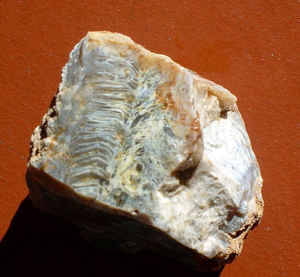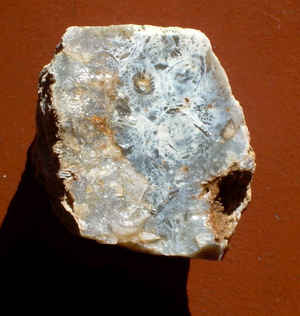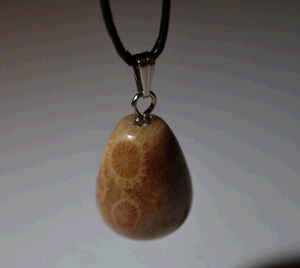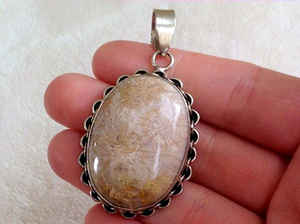

West Virginia Symbols
West Virginia State Gemstone or Gem
Lithostrotionella (Chalcedony)

(Lithostrotionella)
Adopted on March 10, 1990
The State Gem, so designated by House Concurrent Resolution No. 39, March 10, 1990, is technically not a gemstone, but rather the silicified Mississippian fossil coral Lithostrotionella, preserved as the siliceous mineral chalcedony. It is found in the Hillsdale Limestone in portions of Greenbrier and Pocahontas counties and is often cut and polished for jewelry and for display
West Virginia State Gemstone or Gem: Lithostrotionella (Chalcedony)

This coral and many other varieties lived about 340 million years ago, during the Mississippian Period, at a time when the state was encroached on by a shallow sea. In addition to corals, this sea hosted a teeming fauna of brachiopods, trilobites, and fish.
When the coral died, it became saturated with water which contained a dissolved mineral called silica. The silica replaced the coral's decaying
soft parts. In other words, the coral became silicified or mineralized. Cavities in the coral were filled with chalcedony- a variety of quartz. But
it still looks like coral.
The two main types of Paleozoic corals were tabulate and rugose corals. Lithostrotionella is a tabulate coral. Both types were decimated in the great
extinction at the end of the Permian Period, 245 million years ago, which wiped out over 90% of the species of life on earth. They were subsequently
replaced by the scleractinian corals which form our reefs today.
Tabulate corals are colonial corals. The entire tabular coral is called the corallum, while the individual tubular chambers within the corallum are called corallites. While solitary forms of rugose corals were made up of a single corallum with large, cup-shaped calices (cups), most tabulate corals had a large corallum comprised of a colony of corallites (sometimes thousands) with very small calices in which the actual coral animals (polyps) lived. Although the individual coral polyps were generally smaller than their rugose cousins, their colonies often grew to much larger sizes. These types of coral mounds were the reef formers of the Silurian and Devonian seas.

The individual corallite chambers contain thin plates called tabulae (TAB-yu-lee in English, or tah-BOO-lye in classic Latin), which extend across the chambers. The tabulae are what this order of corals are named for. All tabulate corals have tabulae, but they are only obvious in fossils, when the sides or insides of the fossils are exposed. The tabulae are stacked within each corallite, and define successive living chambers of the coral polyp, as it grew. As each coral polyp grew it abandoned its old living compartment and secreted a new skeletal tabula above the old one resulting in the stacked living chambers seen in fossils.

Corals
may look like plants, but they are really animals. The familiar part of a coral is a colony's calcium carbonate skeleton; in each small recess lives
an individual coral animal called a polyp. These polyps strain small particles of food from the water with their tentacles, and retreat into the safety
of the skeleton when threatened. Additionally, the polyps host symbiotic algae called zooxanthellae within their tissues, which are nourished by the
coral's waste products and in turn provide additional food via photosynthesis. These algae give the corals various colors when they are alive. In fossil
form, it is impurities within the minerals that impart various hues. Many West Virginia coral reefs have been replaced by chalcedony, a variety of
microcrystalline quartz.
Lithostrotionella is found almost exclusively in the Hillsdale Limestone of Greenbrier and Pocahontas counties in the southeastern portion of the state.
West Virginia Fossil Coral comes in several colors, including light to dark blue grey, pink, and red.
West Virginia Law
Adopted by House Concurrent Resolution No. 39, March 10, 1990, Mississippian fossil coral Lithostrotionella, preserved as the siliceous mineral chalcedony is, therefore, not recorded as the official gem of the state in the West Virginia Code.
Minerals, & Gems

Gemstone, Minerals, Rocks





